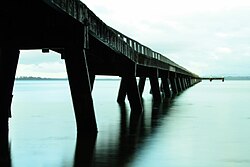|
Kauri Point
Kauri Point is a rural settlement in the Western Bay of Plenty District and Bay of Plenty Region of New Zealand's North Island. It is on a headland on the eastern side of Tauranga Harbour, opposite Matakana Island.[3] A coastal walkway through Kauri Point Historic Reserve connects Kauri Point to Ongare Point.[4] There are mature pōhutukawa trees and three pā sites in the reserve.[5][6] A 200 metre long wooden jetty, built after 1947, provides fishing access to the harbour.[7][8] Dorothy Morris was a pioneer of the kiwifruit industry in New Zealand who she converted her dairy farm on Kauri Point Road to kiwifruit in the 1950s.[9] George Vesey Stewart, who organised settlement of Katikati in the 1870s, initially planned for the town to be established at Kauri Point.[10] The settlement at Kauri Point did not eventuate until the 1970s.[11] DemographicsŌngare Point-Kauri Point is defined by Statistics New Zealand as a rural settlement. Kauri Point covers 0.27 km2 (0.10 sq mi).[1] It is part of the wider Tahawai statistical area.[12]
 Kauri Point had a population of 177 at the 2018 New Zealand census, an increase of 6 people (3.5%) since the 2013 census, and a decrease of 12 people (−6.3%) since the 2006 census. There were 75 households, comprising 84 males and 90 females, giving a sex ratio of 0.93 males per female. The median age was 54.2 years (compared with 37.4 years nationally), with 33 people (18.6%) aged under 15 years, 15 (8.5%) aged 15 to 29, 78 (44.1%) aged 30 to 64, and 51 (28.8%) aged 65 or older. Ethnicities were 89.8% European/Pākehā, 13.6% Māori, 3.4% Asian, and 5.1% other ethnicities. People may identify with more than one ethnicity. Although some people chose not to answer the census's question about religious affiliation, 54.2% had no religion, 27.1% were Christian, and 1.7% had Māori religious beliefs. Of those at least 15 years old, 21 (14.6%) people had a bachelor's or higher degree, and 36 (25.0%) people had no formal qualifications. The median income was $24,900, compared with $31,800 nationally. 21 people (14.6%) earned over $70,000 compared to 17.2% nationally. The employment status of those at least 15 was that 57 (39.6%) people were employed full-time, 24 (16.7%) were part-time, and 6 (4.2%) were unemployed.[2] References
|
|||||||||||||||||||||||||||||||||||||||||||||||||||||||
Portal di Ensiklopedia Dunia

